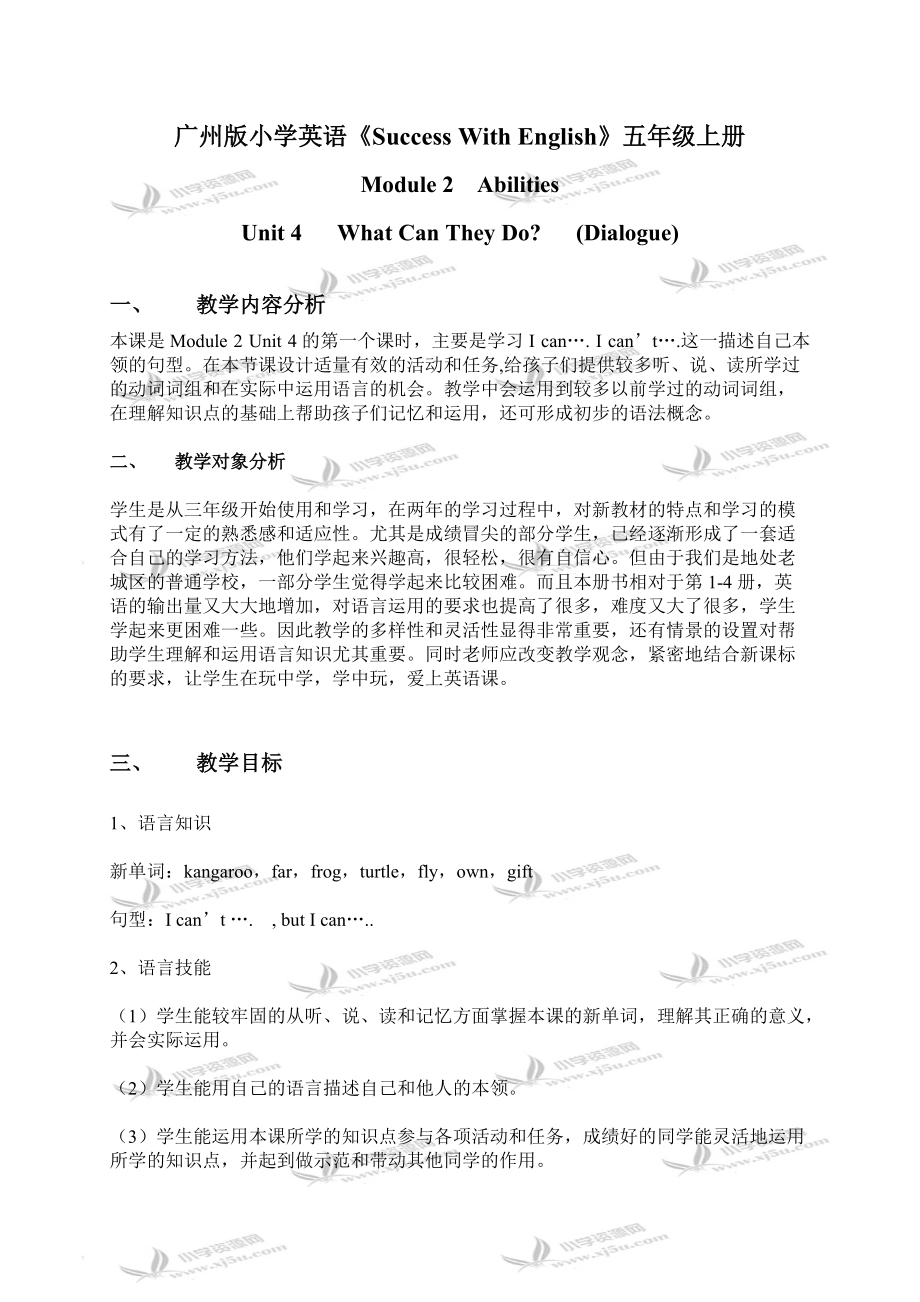




下載本文檔
版權(quán)說(shuō)明:本文檔由用戶提供并上傳,收益歸屬內(nèi)容提供方,若內(nèi)容存在侵權(quán),請(qǐng)進(jìn)行舉報(bào)或認(rèn)領(lǐng)
文檔簡(jiǎn)介
1、廣州版小學(xué)英語(yǔ)Success With English五年級(jí)上冊(cè)Module 2 AbilitiesUnit 4 What Can They Do? (Dialogue)一、 教學(xué)內(nèi)容分析本課是Module 2 Unit 4的第一個(gè)課時(shí),主要是學(xué)習(xí)I can. I cant.這一描述自己本領(lǐng)的句型。在本節(jié)課設(shè)計(jì)適量有效的活動(dòng)和任務(wù),給孩子們提供較多聽(tīng)、說(shuō)、讀所學(xué)過(guò)的動(dòng)詞詞組和在實(shí)際中運(yùn)用語(yǔ)言的機(jī)會(huì)。教學(xué)中會(huì)運(yùn)用到較多以前學(xué)過(guò)的動(dòng)詞詞組,在理解知識(shí)點(diǎn)的基礎(chǔ)上幫助孩子們記憶和運(yùn)用,還可形成初步的語(yǔ)法概念。二、 教學(xué)對(duì)象分析學(xué)生是從三年級(jí)開(kāi)始使用和學(xué)習(xí),在兩年的學(xué)習(xí)過(guò)程中,對(duì)新教材的特點(diǎn)和學(xué)習(xí)的模式
2、有了一定的熟悉感和適應(yīng)性。尤其是成績(jī)冒尖的部分學(xué)生,已經(jīng)逐漸形成了一套適合自己的學(xué)習(xí)方法,他們學(xué)起來(lái)興趣高,很輕松,很有自信心。但由于我們是地處老城區(qū)的普通學(xué)校,一部分學(xué)生覺(jué)得學(xué)起來(lái)比較困難。而且本冊(cè)書(shū)相對(duì)于第1-4冊(cè),英語(yǔ)的輸出量又大大地增加,對(duì)語(yǔ)言運(yùn)用的要求也提高了很多,難度又大了很多,學(xué)生學(xué)起來(lái)更困難一些。因此教學(xué)的多樣性和靈活性顯得非常重要,還有情景的設(shè)置對(duì)幫助學(xué)生理解和運(yùn)用語(yǔ)言知識(shí)尤其重要。同時(shí)老師應(yīng)改變教學(xué)觀念,緊密地結(jié)合新課標(biāo)的要求,讓學(xué)生在玩中學(xué),學(xué)中玩,愛(ài)上英語(yǔ)課。三、 教學(xué)目標(biāo)1、語(yǔ)言知識(shí)新單詞:kangaroo,far,frog,turtle,fly,own,gift句型
3、:I cant . , but I can.2、語(yǔ)言技能(1)學(xué)生能較牢固的從聽(tīng)、說(shuō)、讀和記憶方面掌握本課的新單詞,理解其正確的意義,并會(huì)實(shí)際運(yùn)用。(2)學(xué)生能用自己的語(yǔ)言描述自己和他人的本領(lǐng)。(3)學(xué)生能運(yùn)用本課所學(xué)的知識(shí)點(diǎn)參與各項(xiàng)活動(dòng)和任務(wù),成績(jī)好的同學(xué)能靈活地運(yùn)用所學(xué)的知識(shí)點(diǎn),并起到做示范和帶動(dòng)其他同學(xué)的作用。 (4)聽(tīng)、說(shuō)、運(yùn)用所學(xué)過(guò)的舊知識(shí)。3情感態(tài)度目標(biāo):(1) 通過(guò)學(xué)習(xí),不斷增強(qiáng)英語(yǔ)學(xué)習(xí)的興趣和參與熱情,保持良好的學(xué)習(xí)習(xí)慣。(2) 學(xué)生在學(xué)習(xí)操練過(guò)程中體現(xiàn)與其他的同學(xué)相互協(xié)作,共享榮譽(yù)。(3) 在學(xué)習(xí)的過(guò)程中培養(yǎng)學(xué)生的評(píng)價(jià)能力,形成一種公平的競(jìng)爭(zhēng)意識(shí)。4學(xué)習(xí)策略目標(biāo):(1)運(yùn)用G
4、ame、chant、TPR等教學(xué)方法幫助學(xué)生理解和操練句型,在教師地引導(dǎo)下,在創(chuàng)設(shè)的情景、任務(wù)和活動(dòng)中,個(gè)人、小組、集體交替學(xué)習(xí)。在學(xué)習(xí)的過(guò)程中,鼓勵(lì)學(xué)生合作參與。(2)設(shè)計(jì)貼近學(xué)生實(shí)際和學(xué)生感興趣的活動(dòng)和任務(wù),讓學(xué)生在學(xué)中玩和玩中學(xué)。四、教學(xué)重點(diǎn)與難點(diǎn)本課新單詞的上口及句型的運(yùn)用;句子Everyone has his own gift.的理解。五、教學(xué)媒體動(dòng)物圖片,金太陽(yáng)課件,自制頭飾,自編練習(xí)紙六、教學(xué)過(guò)程(一)Warming up1.Chant:Lucy, Lucy , what can you do? I can dance , I can dance. Can you dance?
5、No, I cant dance , but I can cook. Come and have a look.師做動(dòng)作,讓學(xué)生用 jump, run ,swim,sing 等詞代入劃線部分單詞,以達(dá)到復(fù)習(xí)舊知的目的。2 Free talk: A: . ,. What can you do ? B:I can . ,I can . ,can you ? A: Yes, I can . , and I can ./ No, I cant , but I can .教師先作示范,請(qǐng)一生一來(lái)作以上對(duì)話,然后讓學(xué)生自己提問(wèn)同學(xué),說(shuō)出自己的本領(lǐng)。T: Simon can swim and play ba
6、dminton well, Jacky can run, Emily can play table tennis very well. Different people are good at different things. Everyone has his own gift. 呈現(xiàn)難點(diǎn)句,教單詞:own, gift.3. Leading into the topic :Module 2 Abilities Unit 4 What Can They Do? T: Everyone has his own gift. We have our own gifts, the animals al
7、so have their own gift. Today we are going to talk about the animals abilities . What can the animals do ?. Have the Ss to read the title together.(二)Presentation1. Guessing games to review some words about animals and present the new wordsT: I have some pictures in my hand , there are some animals
8、on them, can you guess what animals they are?在投影器上呈現(xiàn)動(dòng)物的圖片,用紙遮蓋主要部分,只露出身體的一小部分,并進(jìn)行一定的描述,讓學(xué)生猜出動(dòng)物的名稱。 Show the picture of horse, and tell the Ss:It can run very fast. P1: Is it a horse? T: Yes , its a horse. I can run very fast. 教師戴著馬的頭飾,讓學(xué)生一起問(wèn):horse , horse ,what can you do? 教師回答:I can run very fast.
9、Can you run very fast. . 讓學(xué)生戴起馬的頭飾,讓部分學(xué)生問(wèn):horse , horse ,what can you do? 戴著頭飾的學(xué)生一起回答:I can run very fast. Can you run very fast.通過(guò)猜一猜游戲呈現(xiàn)本課的新單詞: kangaroo, far, frog , turtle , monkey , climb, fly . Guessing games 的形式除了老師遮蓋部分動(dòng)物身體的主要部分,只露出突出部位外,還可以讓一學(xué)生出來(lái)看了圖片,然后扮演圖片上的動(dòng)物,并進(jìn)行簡(jiǎn)短的描述,讓學(xué)生猜出是何種動(dòng)物; 又或者由老師或者學(xué)生
10、模仿動(dòng)物的聲音讓學(xué)生猜出動(dòng)物。2 Practise the new sentences: I cant , but I can ./ I can , and I can .Have the Ss act out the animals after they put on the puppy ,and ask and tell the abilities of the animals in groups.T: OK, boys and girls , please put on your puppy and make the dialogue like this.T put on a puppy
11、 of kangaroo, and let a pupil put on a puppy of frog.T: Frog , frog , what can you do ?P1; I can jump and I can swim. Can you jump and swim?T: I cant swim , but I can jump very high and very far. 3. Have 2 or 3 groups act out in class. 4. Lead in the dialogue of unit 4T: Children , you can act out y
12、our own dialogue very well, now, lets watch the dialogue of unit 4, first of all ,please take out the exercise paper, complete Ex . 1 after you listen and watch the video. 播放金太陽(yáng)課件2次, 整體呈現(xiàn)課文,讓學(xué)生邊看邊完成練習(xí)紙上有關(guān)課文的練習(xí),以檢查學(xué)生對(duì)課文的理解。附練習(xí)題:Listen to the dialogue and complete the sentences.(聽(tīng)課文,按照課文的內(nèi)容填空)1.The ka
13、ngaroo _ jump very high and very _ , but it _ swim.2. The _ can swim very fast,but it cant _ very high.3. The turtle _ swim,but it _ jump .4. The bird can _, but it _ swim.5. The boy _ swim and run.6. Everyone has his _ gift.4 讓部分學(xué)生說(shuō)出答案,全班齊讀句子,讓學(xué)生對(duì)課文內(nèi)容有個(gè)整體感知。5 Have the Ss open their books , read the
14、 dialogue after the tape together.(三) Development1. Have the Ss read the dialogue with emotion. and then act out the dialogue in groups.2. Check up.3. Have the Ss tell their partners one of their favourite animals or persons after the demo , then complete EX.2 on the paper sheet . 附題目:二Tell your partner one of your favourite animals or your favourite persons according to the model. Then fill in the blanks.(請(qǐng)仿照例子向你的小伙伴介紹你喜歡的一種動(dòng)物或一個(gè)你喜歡的人物,完成句子。)Eg: I like LiuXiang very much . Hes very tall and handsome . He cant fly.,but he can run very very
溫馨提示
- 1. 本站所有資源如無(wú)特殊說(shuō)明,都需要本地電腦安裝OFFICE2007和PDF閱讀器。圖紙軟件為CAD,CAXA,PROE,UG,SolidWorks等.壓縮文件請(qǐng)下載最新的WinRAR軟件解壓。
- 2. 本站的文檔不包含任何第三方提供的附件圖紙等,如果需要附件,請(qǐng)聯(lián)系上傳者。文件的所有權(quán)益歸上傳用戶所有。
- 3. 本站RAR壓縮包中若帶圖紙,網(wǎng)頁(yè)內(nèi)容里面會(huì)有圖紙預(yù)覽,若沒(méi)有圖紙預(yù)覽就沒(méi)有圖紙。
- 4. 未經(jīng)權(quán)益所有人同意不得將文件中的內(nèi)容挪作商業(yè)或盈利用途。
- 5. 人人文庫(kù)網(wǎng)僅提供信息存儲(chǔ)空間,僅對(duì)用戶上傳內(nèi)容的表現(xiàn)方式做保護(hù)處理,對(duì)用戶上傳分享的文檔內(nèi)容本身不做任何修改或編輯,并不能對(duì)任何下載內(nèi)容負(fù)責(zé)。
- 6. 下載文件中如有侵權(quán)或不適當(dāng)內(nèi)容,請(qǐng)與我們聯(lián)系,我們立即糾正。
- 7. 本站不保證下載資源的準(zhǔn)確性、安全性和完整性, 同時(shí)也不承擔(dān)用戶因使用這些下載資源對(duì)自己和他人造成任何形式的傷害或損失。
最新文檔
- 2025-2030中國(guó)防爆開(kāi)關(guān)柜行業(yè)發(fā)展現(xiàn)狀及發(fā)展趨勢(shì)與投資戰(zhàn)略研究報(bào)告
- 2025-2030中國(guó)防火墻行業(yè)研發(fā)創(chuàng)新策略及需求前景分析研究報(bào)告
- 2025-2030中國(guó)錳鐵合金行業(yè)市場(chǎng)現(xiàn)狀供需分析及投資評(píng)估規(guī)劃分析研究報(bào)告
- 2025-2030中國(guó)鐵路建設(shè)行業(yè)市場(chǎng)發(fā)展分析及發(fā)展趨勢(shì)與投資機(jī)會(huì)研究報(bào)告
- 2025-2030中國(guó)鋼鐵物流行業(yè)發(fā)展趨勢(shì)與前景展望戰(zhàn)略研究報(bào)告
- 2025-2030中國(guó)鈦鐵礦行業(yè)市場(chǎng)發(fā)展趨勢(shì)與前景展望戰(zhàn)略研究報(bào)告
- 2025-2030中國(guó)金融服務(wù)中的后臺(tái)外包行業(yè)市場(chǎng)發(fā)展趨勢(shì)與前景展望戰(zhàn)略研究報(bào)告
- 2025-2030中國(guó)金剛石拋光材料行業(yè)市場(chǎng)需求分析及發(fā)展趨勢(shì)與投資價(jià)值研究報(bào)告
- 2025-2030中國(guó)重型起動(dòng)器行業(yè)市場(chǎng)發(fā)展趨勢(shì)與前景展望戰(zhàn)略研究報(bào)告
- 2025-2030中國(guó)酶聯(lián)免疫吸附試驗(yàn)試劑行業(yè)市場(chǎng)發(fā)展趨勢(shì)與前景展望戰(zhàn)略研究報(bào)告
- 《小兒急性白血病》課件
- 植保員培訓(xùn)課件
- 2023年新《招標(biāo)投標(biāo)法》考試題庫(kù)附答案
- 《斷路器動(dòng)作時(shí)間測(cè)試系統(tǒng)設(shè)計(jì)》13000字(論文)
- 2024年浙江省中考社會(huì)(開(kāi)卷)真題卷及答案解析
- T-CNHAW 0011-2024 干眼診療中心分級(jí)建設(shè)要求
- 內(nèi)蒙古中東部旱地谷子栽培技術(shù)規(guī)程(DB15-T 638-2013)
- 2025屆湖北省武漢市重點(diǎn)中學(xué)高三第一次模擬考試數(shù)學(xué)試卷含解析
- 網(wǎng)店推廣模擬習(xí)題及答案
- 道路管道清淤施工方案
- 智能信貸風(fēng)控策略

評(píng)論
0/150
提交評(píng)論